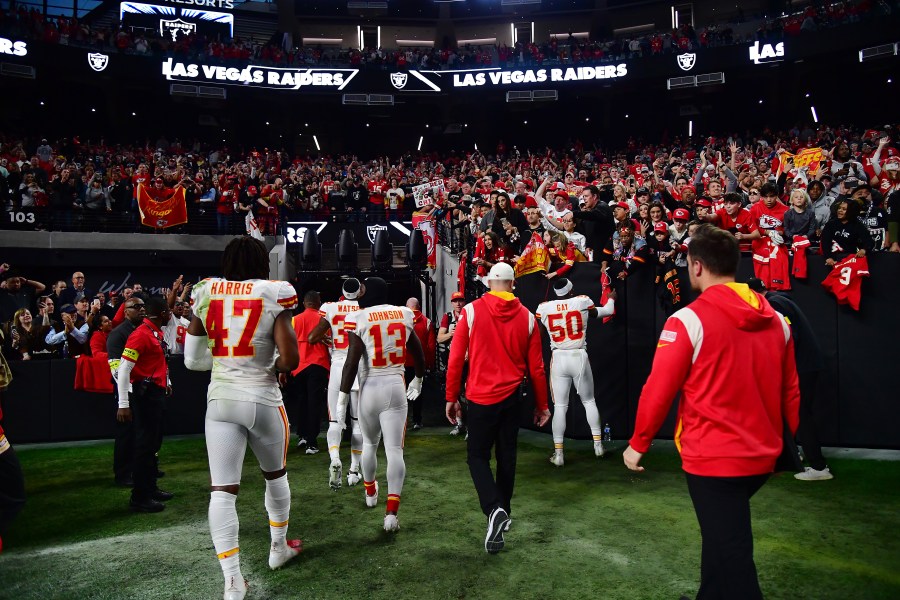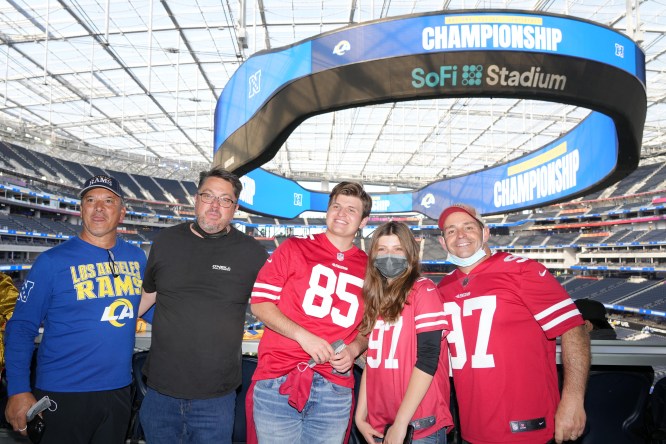
When you think of home-field advantage in the NFL, look no further than the Green Bay Packers’ Lambeau Field. It’s the Yankee Stadium of pro football venues.
Steeped in history and filled every Sunday with the rabid “Cheeseheads,” the images of fans sitting through brutal winter afternoons are intertwined with the game’s history. While other fan bases are just as loyal and just as passionate, the football culture at Lambeau is unlike any other.
Fast forward to Sept. 28 when the Packers hosted the Detroit Lions. As the national television broadcast came on the air, one of the top stories was the amount of Lions fans who had created a tsunami of Honolulu Blue. An estimated 30-40% of Lambeau field was Lions fans and they were loud.
“They’re the best. They’re the best,” Lions quarterback Jared Goff said after the game of the Lions fans takeover. “They showed out tonight like they did the Sunday night game last year. That’s a feeling unlike any other when you’re walking off the field and they’re cheering like that on the road. Especially when you think about from where we’ve come. It’s a pretty good feeling, and we’ve got to keep winning for them.”
Lions fans had done a similar takeover when they traveled en masse to Kansas City for the Thursday night kickoff of the NFL season against the Chiefs. The Lions upset the defending-Super Bowl champs, boosted by their raucous fans.
Lions fans at Lambeau Field is just one example of a growing trend of NFL home teams finding themselves surrounded in their own stadium by large numbers of visiting fans. Since the return of professional football to Los Angeles — the nation’s second-largest media market — it’s become an acceptable reality.
Even in Cleveland, where the Browns’ upset of the previously undefeated San Francisco 49ers last week was performed in front of a sea of red 49ers shirts on a day the Browns wore their “white out” alternate jersey.
But what is fueling these visiting fan “takeovers” and why is it happening more often?
Secondary ticket market and team performance a big factor
Like many other aspects in today’s technologically-connected world, the ease in which fans can buy game tickets is also a growing factor in the increase of visiting fans not only in the NFL but also at MLB and college football games.
Kyle Zorn, a brand manager for the secondary ticket market mobile app TickPick, said the availability of tickets through his app and others make it easier and sometimes more affordable for fans to grab tickets and make a trip to see their beloved team on the road. The location of the road game and the team’s current performance, coupled with the current state of the home team, play a huge factor.
“The biggest factor with a lot of that is winning,” Zorn told Sportsnaut. “So when your team’s doing well, you’re much more inclined to make these trips, but we are definitely seeing that.”
Zorn can relate his own personal experience with the phenomena. He went to Las Vegas’ Allegiant Stadium to see a 49ers vs. Las Vegas Raiders preseason game in August. With Super Bowl expectations this season, and the Raiders in a rebuild again, 49ers fans filled the building.
“I was at the Raiders 49ers preseason game, and one of the videos we took and posted on social media went viral because it was a lot of 49ers fans at the game, and it’s a lot of these you see the destination cities, Las Vegas Los Angeles, beautiful stadiums,” Zorn said.
Destination locations continue to be most effected

When the Raiders moved from Oakland to Las Vegas, one of the questions people raised was about the fan base in the tourist destination. Despite having a metropolitan population of 2.5 million and growing, observers wondered if the sparkling Allegiant Stadium would be overrun by visiting fans without a homegrown fanbase in Las Vegas.
At times, that has been the case. It reportedly raised the ire of Raiders owner Mark Davis last season after Chicago Bears and Kansas City Chiefs fans took over the stadium. With the Raiders off to a 1-3 start early this season, the trend continued, notably on Oct. 8 when the Green Bay Packers came to town. The stands were filled with Packers fans who watched their team lose to the Raiders.
The Raiders are a unique example due to their well-documented relocation history. The team has called Los Angeles home once and Oakland twice. Now relocated to Nevada, almost half of its fan base travels to see home games from their former markets.
While the Raiders might not be the only team seeing this growing trend unfold on their own turf, Zorn said destination locations will always draw visiting fans. That only becomes more prevalent when fall and winter arrive and cold-weather fans look for a warm destination to watch their teams.
“If they’re gonna make the trip, they’re gonna spend the money and you’re seeing that reflected in the pricing in Las Vegas,” Zorn said. “(Las Vegas) has been the most expensive NFL ticket for the last three seasons since they moved over there. But we’re definitely seeing that.”
When analyzing the travel data for road games, Zorn said it becomes evident that Las Vegas is a choice among fans especially when their teams are facing off against teams with traditionally rabid fan bases.
For example, when both the Steelers and Packers were slated to play the Raiders, the data revealed an increase in ticket sales from Pennsylvania and Wisconsin. This pattern implies that if fans can only make one road game trip, Las Vegas emerges as the destination.
Zorn reiterated when teams are winning, and there is more local excitement to generate interest, those who own season tickets are less likely to sell them on the secondary market — meaning hometown fans outnumber visitors. When a team isn’t doing well, inventory grows.
“A lot of the season ticket holders are going to offload tickets if the team isn’t doing well,” Zorn said. “So, there’s going to be a lot more inventory available, but when that home team is doing well, not so much.”
For Raider Nation, which has seen their team advance to the postseason just twice since 2002, the excitement and momentum just hasn’t been there to edge out visiting fans looking to spend a weekend in Sin City.
Do teams lose home-field advantage?

The question of the impact on the home team is at the forefront of the minds of fans, but does it impact the play on the field?
In 2021 when the Chargers played their first home game at SoFi Stadium in Los Angeles, there were so many fans of the visiting Dallas Cowboys that when the Chargers were on offense, they had trouble hearing the snap count.
“It felt a lot of ways like a home game, definitely a home game,” Cowboys coach Mike McCarthy said.
While it clearly gave the Cowboys a boost, Chargers coach Brandon Staley said he welcomed the noise as it added to the game experience for everyone, including his team.
“I felt like there was great energy in that crowd,” Staley said. “My focus was on the powder blue. (Dallas) travels well traditionally, but I didn’t hear them very much. I heard our fans, and I was proud of the energy in that stadium for us.”
Fans providing a home-field advantage might also be a notion of years gone by. According to the Washington Post, even the idea of home-field advantage in the NFL is diminishing over time.
Home teams won just 51.7% of their games in 2021 — the lowest since 2002. The diminishing advantage of home teams isn’t based on fan enthusiasm but on the ever-changing landscape of professional sports.
With better analytics that help road teams prepare, more comfortable and faster travel and the ability to set up mobile training facilities and other technological advances to help road teams, the advantage for home teams has significantly diminished over the years.
When you consider NFL teams travel on chartered plans with interiors on par with commercial first class, the stress level for teams on the road are almost completely gone.
“That really was a game-changer in terms of lowering the stress of travel,” Scott Turlock, former athletic trainer for the Jacksonville Jaguars, told the Washington Post. “Players can be comfortable. They can sleep better. They can eat without being on top of each other. That was a real significant change.”
Fans may want to claim the presence of so many visiting fans is hurting their advantage at home, but the answer to why that has changed is more complex.
Changing demographic of NFL fans has impact
Another reason you’re seeing the visiting fan takeover is the changing demographic of the fans who attend games. Gone is the notion a blue-collar football fan can go see his favorite team at every home game.
The average cost of an NFL ticket is $337, according to Ticketmaster, meaning middle income fans have a tough time forking over the money to see their team. Add in a slew of new stadiums, Personal Seat Licenses and their enormous cost, and you can see why those who can afford them snatch them up — even if it means buying a plane ticket, hotel and rental car.
The secondary ticket market is driven by apps like TickPick, where supply and demand drive prices, not the team or their ticket office. While fans complain about the cost of attending games in 2023, with the popularity of the NFL continuing to grow, it won’t come down anytime soon.
For fans frustrated by the large crowds of fans from enemy territory rolling into their town, some advice:
They may just have to get used to it.